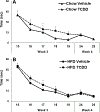TCDD (2,3,7,8-tetrachlorodibenzo-p-dioxin) induces depression-like phenotype
- PMID: 38838945
- PMCID: PMC11288769
- DOI: 10.1016/j.neuro.2024.05.010
TCDD (2,3,7,8-tetrachlorodibenzo-p-dioxin) induces depression-like phenotype
Abstract
The etiology of major depressive disorder (MDD) remains poorly understood. Our previous studies suggest a role for the aryl hydrocarbon receptor (AhR) in depression. 2,3,7,8-tetrachlorodibenzo-p-dioxin (TCDD) is a toxic environmental contaminant, with a high AhR binding affinity, and an established benchmark for assessing AhR activity. Therefore, this study examined the effect of TCDD on depression-like behaviors. Female mice were fed standard chow or a high-fat diet (HFD) for 11 weeks, and their weight was recorded. Subsequently, they were tested for baseline sucrose preference and splash test grooming. Then, TCDD (0.1 µg/kg/day) or vehicle was administered orally for 28 days, and mice were examined for their sucrose preference and performances in the splash test, forced swim test (FST), and Morris water maze (MWM) task. TCDD significantly decreased sucrose preference, increased FST immobility time, and decreased groom time in chow-fed mice. HFD itself significantly reduced sucrose preference. However, TCDD significantly increased FST immobility time and decreased groom time in HFD-fed mice. A small decrease in bodyweight was observed only at the fourth week of daily TCDD administration in chow-fed mice, and no significant effects of TCDD on bodyweights were observed in HFD-fed mice. TCDD did not have a significant effect on spatial learning in the MWM. Thus, this study demonstrated that TCDD induces a depression-like state, and the effects were not due to gross lethal toxicity. This study further suggests that more studies should examine a possible role for AhR and AhR-active environmental pollutants in precipitating or worsening MDD.
Keywords: Aryl hydrocarbon receptor (AhR); Environmental pollutant; Major depression; Spatial learning.
Copyright © 2024 Elsevier B.V. All rights reserved.
Conflict of interest statement
Declaration of Competing Interest The authors have no conflicts of interest.
Figures




References
-
- Barrett DH, Morris RD, Akhtar FZ and Michalek JE (2001). “Serum dioxin and cognitive functioning among veterans of Operation Ranch Hand.” Neurotoxicology 22(4): 491–502. - PubMed
MeSH terms
Substances
Grants and funding
LinkOut - more resources
Full Text Sources
Medical
Miscellaneous

